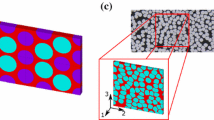Abstract
The hybrid composite consists of n(n > 2) jointly working phases. We define the thermomechanical characteristics and strength of composites by filling and reinforcing materials thermomechanical characteristics and strength basing on the suggestion that thin and strong fibre reinforced composite is quasiuniform, and there is a continuous contact between the filling medium and reinforcing fibers. The development of a mathematical model of the design under consideration has been based on following assumptions: 1) for irreversible processes, the classical thermodynamic postulates are valid, and they are introduced as functions of state of internal energy and entropy; 2) for a solitary volume of materials, internal energy is assumed to be proportional to the volume fraction of the j-th phase vj; 3) for the material pressure limit conditions just before the essential damage, it is suggested that: a) the whole composite as well as the components are steady, i.e. Drukker's postulate is valid; b) the deformation law associated with the corresponding strength surface is valid, and c) small values of increases in plastic deformation play the leading role. The strength of unidirectionally reinforced hybrid monolayers is predicted by using a linear programming code.
Similar content being viewed by others
References
A. K. Malmeister, V. P. Tamuzh, and G. A. Teters, Strength of Polymer and Composite Materials [in Russian], Riga (1975).
R. Christensen, Introduction to Composite Mechanics [Russian translation], Moscow (1982).
R. B. Rikards, The Finite Element Method in Shell and Plate Theory [in Russian], Riga (1988).
Van Fo Fi, Construction of Reinforced Plastics [in Russian], Kiev (1971).
D. S. Abolin'sh, “Compliance tensor for a unidirectionally reinforced elastic material,” Mekh. Polimerov, No. 4, 52–59 (1965).
I. F. Obraztsov, V. V. Vasil'ev, and V. A. Bunakov, Optimum Reinforcement of Shells of Rotation Made of Composite Materials [in Russian], Moscow (1977).
V. A. Lomakin and M. A. Yumasheva, “Relationships between stresses and strains with linear deformation of orthotropic glass-reinforced plastics,” Mekh. Polimerov, No. 4, 28–34 (1965).
Yu. N. Rabotnov, “Elastoplastic state of a composite structure,” in: Problems of Hydrodynamics and Solid Mechanics [in Russian], Moscow (1969).
Yu. V. Nemirovskii, “Elastoplastic behavior of a reinforced layer,” Zh. Prikl. Mekh. Tekh. Fiz., No. 5, 81–90 (1969).
Progress in Engineering, No. 1, Composite Materials [in Russian], Moscow (1987).
A. F. Ermolenko and V. D. Protasov, “Effect of the level of reinforcement on the strength and nature of failure of unidirectional fiber composites,” Mekh. Kompozit. Materialov, No. 2, 276–283 (1989).
V. I. Kulik, E. V. Meshkov, G. P. Lashmanov, and A. S. Nilov, “Study of the deformability and strength of unidirectional carbon-reinforced plastics with a plane stressed state,” in: The Interface, Strength, and Failure of Composite Materials [in Russian], Leningrad (1989).
Yu. V. Nemirovskii and S. S. Pyataev, “Strength and stiffness of composite materials with a fibrous structure taking account of the transition zone,” Prikl. Mekh.,27, No. 10, 61–66 (1991).
W. W. Fend, “A failure criterion for composite materials,” J. Composite Materials,25, No. 1, 88–100 (1991).
I. G. Teregulov, “Nonelastic deformation of fibrous composites,” in: Proc. Intern. Symp. ‘Composites: fracture mechanics and technology,’ (S. T. Mileiko and V. V. Tvardovsky (eds.), Russian Composite Soc., Chernogolovka, September 22–25, 1992.
Author information
Authors and Affiliations
Additional information
Translated from Mekhanika Kompozitnykh Materialov, Vol. 31, No. 2, pp. 186–192, March–April, 1995.
The studies were carried out with financial support of the International Scientific Fund founded by G. Soros.
Rights and permissions
About this article
Cite this article
Teregulov, I.G., Sibgatullin, É.S. & Falyakhhov, M.A. Deformation and strength of hybrid composites reinforced with unidirectional fibers. 1. Numerical models. Mech Compos Mater 31, 131–136 (1995). https://doi.org/10.1007/BF00616280
Received:
Issue Date:
DOI: https://doi.org/10.1007/BF00616280




